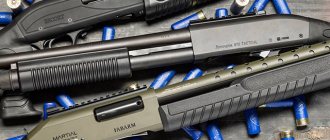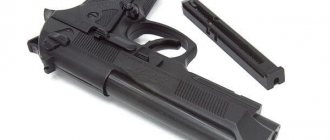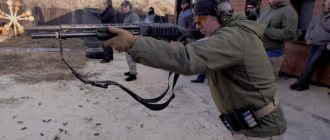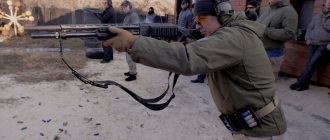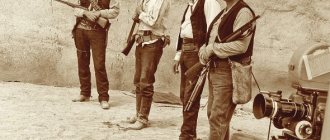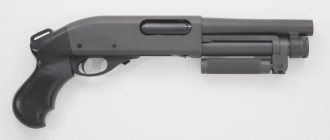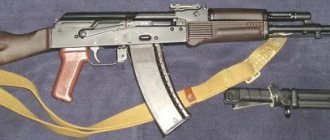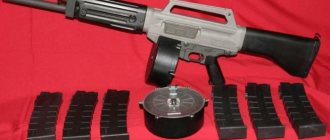The USA represents many peace symbols that are very popular in almost all countries. Jeans, Coca-Cola, Wrigley chewing gum, Ford and Pontiac cars, baseball and other attributes of the New World, along with rock and roll, jazz or the novels of Fitzgerald and Hemingway, express the influence of the American way of life on the planetary culture. But it just so happened historically that some fairly significant part of overseas symbolism shoots or explodes. A Maxim machine gun, a Phantom airplane, an M-16 carbine, a Boeing bomber—these inanimate objects also illustrate the global expansion of the United States. The very first stamps from the “shooting” series were Colt and Winchester. Weapons have long been the most important American export.
Winchester sounds proud
The generation that grew up watching cowboys and Indians associates this word with the rifle that Western characters, both positive and negative, fired from. With the beginning of the computer revolution, the word “screw” (short for English Winchester) began to mean the most important component of a PC, a disk magnetic storage device, which initially had a capacity of 30 megabytes on two modules. Abbreviated "hard drive" was designated by the numbers 30-30, just like the rifle cartridge. The 1873 weapon gave its name to IBM products a century after its introduction. The popularity of the word is also promoted by the television series “Supernatural” (Warner Brothers), although in this case there is only a coincidence of the name of the main character with the famous brand. Dean Winchester's favorite weapon, fighting various evil spirits, is not the famous cowboy carbine, but a sparkling chrome antique Colt revolver (model 1911) with a handle inlaid with mother-of-pearl.
All this is just an echo of the formidable glory of repeating rifles that thundered across the prairies and cities of the New World since the 60s of the 19th century and became a legend.
Origin of the brand
Oliver Fisher Winchester was born in Boston in 1810. The weapon named after him became one of the symbols of America, but in 1857, when he founded, nothing foreshadowed future success. The company produced good rifles, no different from others except for the presence of a magazine that increased the rate of fire. The presence of firearms in every American home has been and remains commonplace, the right to do so is guaranteed by the US Constitution. In those days (and in a sense today too) it could perform a double task. They hunt with a gun, and they also use it to protect their home from thieves and robbers.
Who was Benjamin Henry
In 1860, the talented inventor B. Henry joined the company and improved the Winchester carbine. The weapon, which now included a tubular-type under-barrel magazine, required a special rimfire cartridge. This ammunition was branded with the Latin letter “H” (the initial Henry) on the bottom of the case and was also produced by the company, bringing in considerable income.
The Henry rifle also received another unit that made it easier to fire: the bolt was controlled by a lever, it could be cocked without removing the butt from the shoulder, which reduced the time to bring the weapon into combat readiness and increased the rate of fire. Not only during hunting, but also during unwanted encounters with robbers or Indian tribes, this quality could play a decisive role in preserving the life of the shooter.
Style icon
Despite the active and adventurous career of the Spencers, the general public is not primarily associated with weapons like Lever Action. “Where are these elegant rifles with golden receivers, with the help of which Pierre Brice and Gojko Mitic dealt with the pale-faced scoundrels in the films of our childhood?” - demanding readers will ask.
Classic Western legend John Wayne (still from the movie Stagecoach)
Now we’ll just talk about them. In the same 1860 as Christopher Spencer, another American gunsmith, Benjamin Tyler Henry, who worked at Oliver Winchester’s enterprise, introduced his “lever” to the world. The Henry rifle also used a rimfire cartridge in a copper case loaded with a lead bullet and a charge of black powder, but Henry made the tubular magazine permanent and moved it from the stock to under the barrel. The cartridge that the rifle fired - .44 Henry Rimfire - was significantly inferior in power to the Spencer ammunition, but as many as 15 of them fit into the magazine of the Henry rifle, and another one was immediately fed into the chamber. As Confederate Army Colonel John Mosby, famous for his daring sabotage raids behind Northern positions, said in this regard, “a damn Yankee rifle, loaded on Sunday, can shoot all week.” In addition, the movement of the lever on the Henry rifle not only ejected the spent cartridge case or misfired cartridge, but also cocked the hammer - thanks to which the rate of fire of the new weapon increased sky-high. Henry also changed the shape of the lever itself, combined with the trigger guard, for greater convenience for the shooter; and since almost all subsequent creators of “lever guns” used in their designs either an exact copy or a slightly modified version, this type of weapon is most often called “rifles with a Henry brace.”
The Henry rifle, which is more compact compared to full-size “Spencers” (total length - only 44.75”, or 114 cm) and, in addition, has a higher rate of fire, more than twofold superiority in ammunition and greater ease of use, has become widespread in throughout North America. During the Civil War, these weapons managed to fight for each side (in addition to the already mentioned Colonel Mosby, we also note that Henry rifles were armed with some Confederate detachments from Louisiana, Virginia and Texas, as well as the personal guard of Confederate President Jefferson Davis), and after it was widely used during the conquest of the Wild West. To be fair, the West often fiercely resisted conquest and sometimes also used Henry rifles to do so; for example, in the famous Battle of the Little Bighorn, both General Custer’s cavalrymen and the opposing Indian forces of the leaders Bile, Sitting Bull and Crazy Horse fired from them.
Despite the popularity of Henry rifles, only about 14 thousand units were produced in total. They were manufactured by New Haven Arms in the period 1860-1866, after which a new era began in the history of “Lever” - the era of “Winchesters”.
1873rd
In 1873, the design of the gun was redesigned. Benjamin Henry improved the receiver, giving it a steel frame and enlarging the magazine bolt. In addition to the 44-40 caliber, the range was increased (38-40 and 32-20), which made it possible to use revolver cartridges, popular at that time, for this rifle.
It is interesting to consider the combat cycle of using a Winchester rifle. The weapon, whose design is extremely simple, works very reliably. When the lever is extended, the firing pin and bolt are displaced, which allows the cartridge from the magazine to be pushed into the chamber. In this position, the weapon is cocked. After pressing the trigger, the firing pin ignites the cartridge. After the shot, the lever should be pushed forward again, the extractor and ejector push out the spent cartridge case and make room for a new charge.
For all its simplicity, the Winchester carbine of the 1873 model was famous for its “indestructibility”, due to the excellent quality of materials and high manufacturing precision. More than 750 thousand copies were released.
At the beginning
One of the first known examples of long-barreled rifled weapons reloaded with a swinging lever is considered to be the Spencer rifle. Designed by Christopher Spencer in 1860, this weapon was a hand-loading rifle with a replaceable (!) tubular magazine with a capacity of seven rounds located in the butt. The Spencer sample is considered the first army repeating rifle designed to use a unitary metal cartridge - it fired a .56-56 Spencer rimfire cartridge (it should be noted that in this designation “.56” does not mean the bullet caliber, as is customary now, but transverse The diameter of the cartridge case is, respectively, at the rim and at the muzzle; the bullet in diameter had a diameter of 0.52 "). Cartridges with a copper case, a lead bullet and a black powder charge (their energy was approximately equivalent to a shot from a .58-caliber army muzzle-loading musket) were placed in a magazine shaped like a cylindrical tube. After firing, by moving the lever, the spent cartridge case was ejected, and a new cartridge came from the magazine into the chamber - however, the hammer had to be cocked manually each time. After the magazine was empty, it had to be removed from the butt of the rifle and replaced with a new one, pre-loaded. Compared to the aforementioned musket, capable of firing no more than two or three bullets per minute even in the hands of an experienced shooter, the Spencer’s rate of fire reached 20 aimed shots per minute - at that time this was unprecedented firepower. The Spencer weapon was produced in two versions: a full-size rifle with a 30" barrel and a carbine with a 22" (later 20" barrel); The rifle was adopted by the United States Navy and the Federal Army (however, not to replace the above-mentioned musket, but for parallel use), and the carbine was adopted by the cavalry. Both options were actively used by the northerners during the Civil War. A number of "Spencers" were also captured by Confederate troops - who, however, were never able to use them for their intended purpose due to the inability of the Southern industry to establish serial production of metal cartridges.
Spencer rifles and carbines were produced from 1860 to 1869. In total, more than 200 thousand units of these weapons were manufactured.
Weapons of hunters and cowboys
During the years of exploration of the endless prairies, settlers had in their hands revolvers and shotguns of various systems, produced by many companies, and not only American ones. It so happened that the characteristic appearance of the carbine delighted film directors, and through their efforts it became the most famous element of the “cowboy” image, with the exception, of course, of the Colt revolver, which “made people equal.” However, it should be remembered that both the 1860 and 1873 models, and the models of subsequent years, are not combat weapons, but primarily hunting weapons. Winchester, however, turned out to be so convenient that it attracted the interest of the military, and not only in the United States.
Winchesters in military service
Not immediately, but very soon after its appearance on the arms market, the company began to receive orders for the supply of large quantities of multi-shot carbines, from which it was possible to fire with a fairly high intensity.
In 1877, the Russian-Turkish War began. The main firearm of the Ottomans was an American rifle equipped with a Winchester under-barrel magazine. This weapon was studied by Russian gunsmiths after it came into their possession as a trophy. Subsequently, high accuracy, excellent alignment and excellent workmanship prompted the Imperial General Staff to recommend this model for purchase. It also had disadvantages: the penetrating power of the cartridge did not meet modern requirements, but this issue was resolved in the first year of the First World War. A carbine was designed especially for the Russian army, designed for a standard three-line caliber cartridge of the Mosin rifle. However, this model, which was based on the 1895 model, was not widely used among the troops. Russian factories regularly supplied the army with high-quality small arms, and the country did not need to import large quantities. But this gun was highly appreciated by hunters - it was rifled.
Winchester is a weapon used by the British in the Boer War (1899-1902), but it turned out to be too expensive and complex.
Levers in the 21st century
It is easy to notice that, starting from the 20th century, “lever” practically ceased to be used in military affairs. The reasons for this are quite obvious: if their fighting qualities were enough for a small group of settlers, placing wagons in a ring, to successfully fight off a crowd of representatives of the primitive communal system, then for wars between advanced industrial states more effective weapons were needed. At first, rifles with a longitudinally sliding rotary bolt and a middle magazine, loaded using clips or packs with smokeless powder cartridges with bottle casings and pointed bullets, became this way. Then manually reloading magazine rifles replaced semi-automatic systems, then automatic weapons appeared - and it’s scary to even imagine what will be used by the troops in another 100 years. “Lever” seemed to forever remain in the time when huge herds of unafraid, shaggy bison roamed across the endless plains, there were no asphalt highways in sight, and travelers who stopped for the night had to sleep with half their eyes open so as not to decorate the wigwam with their scalps some local authority.
Loading an under-barrel magazine is not the most pleasant procedure for the fingers
Partly because of its historical uniqueness, weapons with a Henry brace continue to be used and are popular among hunters - both at home and far beyond the borders of North America. And even if bison were never shot in our latitudes with Spencers or Sharps - so what? These are just insignificant details - and if you personally want to consider yourself a distant descendant of Davy Crockett or Dan Boone, in some magical way, born in Vinnitsa, Chernigov or Kyiv, then who will forbid you?
The remaining reasons for the popularity of “lever guns” are absolutely objective - these weapons are still extremely effective in skillful hands, since game has not changed at all over the past 200 years (and, in fact, during the entire existence of firearms). And if at the end of the 19th century a .30-30 cartridge with a bullet cast by hand from lead by the shooter himself (using the mold supplied with the rifle - but what?), or a .45-70, the charge of black powder into which was measured with a volumetric measure, was successful hunted game from antelope to bear, it is foolish to think that their modern versions with highly effective expansion bullets, equipped with modern high-energy gunpowder, for some reason will not cope with a similar task.
However, it is time to move from poetry to substance. Today we have two "lever" from Marlin Firearms - model 336BL in .30-30 Win and model 1895GS chambered in .45-70 Government.
Expensiveness and quality
Indeed, in the modern understanding, the manufacturing technology can be called not just outdated, but barbaric. Milling and a huge number of manual operations, material consumption and careful fitting - all these stages of the production cycle would lead today's metalworker to complete despondency. However, it was precisely thanks to such careful execution that the Winchester weapon became famous. Photos of surviving examples show not only perfectly polished surfaces, but also filigree engraving, giving the carbines a sophisticated look (at least in the cowboy or hunting sense of the word). An excellent selection of steel grades guaranteed a long service life, subject to proper care.
The lineup
After 1880 (when O. Winchester died), the model range changed several times. Every two to four years a new model appeared, differing from the previous one in design (carbine or rifle), magazine capacity or caliber. A large-caliber model was offered to fans of African safari in 1886. The Model 1895 featured a mid-mount (rather than tubular) magazine coupled with a distinctive lever-type bolt. In 1912, gunsmith designer Thomas Crosley Johnson created the Winchester M12 pump-action shotgun based on the 1897 model. Its popularity broke all records: over two million copies of this model were produced, and production continued until 1963.
Shotguns were not forgotten either. In 1914, the company began producing 12-gauge Winchester smoothbore weapons, a little later - 16-gauge, and in 1934 - 29-gauge.
Shorties
When I first look at them, I immediately remember the shots from “Stagecoach” - a very young John Wayne, sitting next to a wildly whipping horse coachman, shoots back at the Apaches with something short-barreled, but due to the presence of a butt, it is clearly a rifle. Both of our marlins are short, spinning and light. The 336BL is 37" (94 cm) long, the 1895GS is exactly the same, and they weigh almost the same - 7.5 and 7 pounds respectively (3.4 kg and 3.18 kg). For those who understand the military weapons of the former Warsaw Pact, these figures will probably seem familiar: the AK-74 assault rifle without cartridges weighs 3.3 kg with a total length of 94.3 cm; Thus, we can assume that our levers in ease of use are at least as good as the well-known Kalash.
Externally, the “lever” looks impressive, and also vintage; and a significant amount of vintageness is ensured by the presence of many screw heads - on the sides of the receiver, on the axis of the trigger guard, in the front end of the forend, and so on. In addition, the screw splines are classic diametrical slots - and this can only be welcomed, since at the time of the conquest of the West there were no Torxes or even Allens. The metal parts of the 336BL model are made of chrome-molybdenum steel with a protective blued finish, the fore-end and stock with a pronounced semi-pistol grip and the fore-end are made of brown laminate, the trigger guard loop has a rounded shape and is oversized. The large-caliber 1895GS is made of stainless steel, the butt and fore-end are made of dark American walnut, and the stock neck is straight. The 1895GS trigger guard hinge is a standard size and is almost rectangular in shape. A narrow bracket is a disadvantage, since the fingers become skewed when moving. The larger bracket of the 336BL model has an advantage in this regard right from the start; and a bracket with such a hefty “loop”, like that of Chuck Connors in “Shooter”, is generally capable of turning the “lever” practically into a machine gun - look for fragments on Youtube, you won’t regret it.
Compact dimensions and light weight with sufficient ammunition power and quite serious ammunition (the 336BL magazine capacity is six rounds, the 1895GS magazine capacity is four rounds, and one more can be immediately chambered) determine the tactical purpose of the participants in our review. Obviously, short-barreled “levers” (the barrel length of both 336BL and 1895GS is 18.5”, that is, 47 cm) in any caliber are not suitable for, for example, mountain hunting for ibex and argali, as well as for hunting some antelopes or saigas in a bare steppe devoid of any natural shelters - as they had not approached before (it is no coincidence that the overwhelming majority of American bison were killed from single-shot "Sharps"). But for hunting in wooded areas, when on the way to a room or to a hiding place you have to wade through dense thickets (as the natives picturesquely say, “hashchi”), the small overall dimensions of the lever will be appreciated by the user on the very first day of hunting. In addition, here the steep trajectories of blunt-pointed bullets will not become a hindrance in any way, because the shooting distances, thanks to the same “hacks”, are frankly small. The blunt-pointed bullets themselves will only be a “plus” - unlike streamlined bullets, they behave much more confidently when encountering obstacles such as bushes, reeds or tall grass.
Adjustable rear sight with antler slot
The marlin fly is reliably protected from any adversity
Here we also remember such a concept as a guide gun, that is, “a guide’s weapon.” When hunting for large and dangerous animals (for example, in Africa), the hunt organizer usually assigns a professional hunter to help the client, who thoroughly knows the situation, the game and all other local situations. Additionally, such a guide is responsible for preserving the life and health of the client, including his protection in the event of an attack by a disturbed animal or an angry wounded animal.
The under-barrel magazine of the 1895GS model is shortened
It is clear that it is most comfortable to protect a client with the help of a weapon - and the weapon, in this case, is chosen based on the principle of maximum stopping power. Of our two “lever guns”, the 1895GS is naturally more suitable for the role of “guide gun” - you can stick your finger into its barrel. As for the 336BL, it gets the role of a kind of station wagon for all occasions. And if you suddenly have to deal with a wounded weapon, we will try to compensate for the lack of stop effect with a rate of fire and increased ammunition.
Decline
Usually during wars, arms companies flourish. This happened with: in 1914-1918, she received large orders from the War Ministry. Management, however, was unable to properly manage the profits that fell on its head. The proceeds were spent on expanding production in the hope, obviously, that the war in Europe would last forever. But everything ends sooner or later, and after the surrender of Germany, the demand for weapons fell. The situation could still be corrected: the company’s management had all the means at its disposal, including an excellent machine park and qualified personnel, but, apparently, it could not find the right solution. Attempts were made to repurpose capacities for the production of hunting knives and auxiliary components, but they did not bring the desired prosperity.
Video: Review of the Winchester 1300 shotgun
Review of the Winchester 1300 pump-action shotgun in this video.
It allows you to unlock the bolt immediately after firing, which saves reloading time. There are several different Winchester 1300 rifles that vary in size. The length can be from 457 to 711 mm, and the weight is 3 – 3.2 kg.
In some countries, the gun is still in service in some branches of the armed forces, so this weapon cannot be considered completely out of production. Now more modern types of weapons are used, for example the Anzio rifle.
Change of brand owner
Despite financial setbacks, it continued to produce products throughout the post-war years, but debts grew, and in 1931, the company, along with the famous trademark, was acquired at a reasonable price by the industrial group of John M. Olin (Olin Western Cartridge Company), specializing in the production of cartridges and cartridges . The change in management benefited the factories, which had stagnated without large orders. Successful marketing moves were made using the established stereotypes of mass thinking at that time. In the early thirties, Hollywood was massively filming westerns, the heroes of which were constantly shooting, and one of the most popular “characters” was the “Winchester” - a weapon. The carbine did not need any special advertising; hunters, trying to imitate the conquerors of the Wild West, began to buy it again. The quality remained at the same level, and the price, although considerable, was quite affordable for most Americans. The period of the 30s and 40s is considered the time of the second coming of Winchester.
Meanwhile, in the same Connecticut
No matter how illustrious and successful the history of Winchester and its products has been, one should not think that no one else in the United States can boast of its “leverage”. You don’t even have to go far: no less successful weapons companies can be found in the same New Haven, Connecticut. It was here in 1870 that engineer and entrepreneur John Marlin founded the Marlin Firearms company, which has since become one of the most renowned manufacturers of Henry brace rifles in the world and, at the same time, the main competitor of the above-mentioned Winchester Repeating Arms. And don’t let the term “main competitor” mislead you: in this case, we don’t mean “a competitor who’s breathing down our necks,” but a “competitor who looms ahead”—there is no one to compete with Marlin Firearms in terms of “lever” sales volume.
John Marlin's company released its first "lever" in 1881 - and immediately chambered quite powerful .38-55 and .45-70 cartridges, capable of catching not only "American common game" like white-tailed deer, but also animals that could easily kill repelling a hunter (like bison or bears). It is clear that the weapon turned out to be somewhat heavy. Trying to improve ergonomics while maintaining power potential, company engineer Lewis Hepburn introduced a fundamental change in the design of the receiver in 1888 - rightly believing that the extraction window at the top of the receiver did not add strength to it, Hepburn moved it to the side. Since 1889, all levers manufactured by Marlin Firearms have had the so-called solid flat top design: no cutouts at the top, a solid steel monolith; in addition to strength (in the future of switching to nitro-powder, the safety margin, as we know, does not last in the pocket), this solution also ensures ease of installation of optical sighting devices. A few years later, another advantage of this receiver design became apparent: during the height of the “gold rush” in Alaska, when hunting large and dangerous game in the winter, when the air temperature dropped well below zero, the “lever” with the upper extraction window constantly experienced icing due to the shutters jam; I think there is no need to explain what this entails.
Brace Model 336BL with an enlarged “loop” in the forward position, the bolt is pulled back, the hammer is cocked; When the bolt is locked, the L-shaped protrusion presses out the automatic safety
Based on a design patented by Lewis Hepburn in 1893, the 1894 and 1895 Marlins are still produced today. They are accompanied by the Model 336, released in 1948 - its design is also based on Hepburn's patents, but was further improved in the 20th century. This “lever” from Marlin Firearms is second only to the “Winchester 94” in sales volume. It should be noted that in 2007, Marlin Firearms was acquired by Remington, and now the Marlin 336 is produced at the production facilities of this oldest American firearms company - but still under the original brand.
Weapon device
From a modern point of view, it is difficult to say that the Winchester is a weapon that is very easy to use. Its use requires some skills acquired during operation. When loading, the forend of a pump-action shotgun must be moved forward and then back until it makes a characteristic click. The bolt frame is connected to it by only one rod, which, however, is quite sufficient. After several repetitions of this operation, the necessary skills appear. The design does not have a magazine cutter. A gun can be fired in two ways: conventionally and by jerking the fore-end while the trigger is pressed.
The receiver and butt make up one half of the split shotgun, and the forend and barrel make up the other. Partial disassembly, cleaning and lubrication are not particularly problematic.
The pump-action model was developed in 1897 and is the signature achievement of John Browning.
The Ballad of the Winchester: Steps to Perfection
The immediate predecessor of the M1894 Winchester is the M1886 Winchester chambered for .45-70 caliber
“Even a blind man will understand what’s going on,” he said.
This bullet has a soft nose and a steel jacket, and yours has a soft nose and a steel jacket. Here thirty - thirty; and your thirty is thirty. This one is from the D. and T. plant, and yours is from the D. and T. plant. Let’s go to the shore and see how you arranged everything.” (“Smoke Bellew” Jack London) Weapons and companies.
Let's start by once again recalling that... gunsmith John Moses Browning was a very talented designer and, what is also very important, he never sat idle.
Before his M1885 rifle had time to go into production, he followed it up with another, truly iconic model of the “Winchester” M1886. It must be said that after the release of the M1873 Winchester, it was soon followed by the M1876 model, which differed only in that it became the first model of a carbine from this company that could fire powerful centerfire rifle cartridges of .45-75 caliber.
This cartridge was very similar to the army .45-70 Government, so there is a clear goal to seduce the American army with this model. Moreover, the only difference was the heavier receiver, which was required to withstand the high pressure developed by the rifle cartridge at the moment of firing.
The Model 1876 was also produced in .40-60, .45-60 and .50-95 Express cartridges. This model has gained particular popularity among bison hunters, and it’s clear why - thanks to its exceptional killing power.
However, the cartridges in this rifle were old, filled with black black powder!
Receiver of the M1886 rifle. Its differences from earlier models are immediately noticeable. The receiver does not have removable “cheeks” or a boss for mounting the reloading lever. The box itself is solidly milled and open at the top.
Stage one: model 1886
As for the Model 1886, designed by John Browning, it was designed to fire even more powerful rifle cartridges than the Model 1876, such as the .45-70, .45-90 and .50- 110 Express.
Therefore, he had to redesign its mechanism, which had not changed since 1873, and at the same time completely change the bolt locking system.
However, the cartridges for this rifle were still filled with black powder. However, the strength of both the barrel and its bolt was such that in 1903 the M1886 barrels were reamed for .33 WCF (8.6 mm) smokeless powder cartridges.
In 1935, it introduced a slightly modified M1886 called the "Model 71" chambered in .348 Winchester (8.8 mm). In total, more than 160,000 M1886 rifles were produced.
The receiver of the M1992 rifle was practically no different from the previous model.
Stage two: model 1892
The next step on the path to the most perfect “Winchester” was the model developed by Browning in 1892.
Moreover, when the company asked him to make an improved version of the M1886, capable of competing with a recent model of a similar rifle, Browning said that he would complete this work in less than a month. And if he’s late, he won’t take money from the company. As a result, two weeks later he presented a prototype of the M1892 rifle. It was initially chambered in .32-20 (7.94 mm), .38-40 (10.17 mm) and .44-40 Winchester (10.8 mm), followed by a . 25-20 (6.6 mm). A certain number of M1892 in 1936-1938. was produced in .218 Bee caliber (5.7 mm). But the .44-40 caliber rifles proved to be the most popular, far outselling all others.
This photo clearly shows the main difference between the M1892 and the rifles of 1873 and 1876. The bolt became rectangular, sliding in the grooves of the receiver (previously it was round). And a U-shaped wedge appeared, locking it, which was lowered and raised by the same bracket-lever. It moved in the grooves of the receiver and fit into the grooves of the bolt.
But in this photo you can clearly see the M1892 bolt, the ejector spring located on top of it and two protrusions of the U-shaped locking wedge that hold the bolt in the locked position.
The great popularity of this model is evidenced by the fact that the M1892 was used by Admiral Robert E. Peary during his travels to the North Pole.
And on December 13, 1932, the millionth rifle was presented to Secretary of War Patrick Hurley. The famous Amazon explorer Percy Fawcett was also armed with this rifle.
And the British Royal Navy used 21,000 copies of this “Winchester” during the First World War. Interestingly, at the very beginning of the same World War I, the Royal Flying Corps purchased Model 1886 rifles chambered for .45-90 Sharps (11.6 mm) cartridges, equipped with special incendiary bullets designed to ignite hydrogen in German airships.
A still from the 1948 movie “California Burning”, where the locking wedge on the M1892 lever bracket is clearly visible.
from Eibar in Spain copied the 1892 model.
And it began to produce it under the name “Tiger” chambered for .44 Largo (.44-40 Winchester) cartridges with a 22-inch barrel, a 12-round magazine and a saddle ring, and many rifles were equipped with swivels.
Well, in total, from 1915 to 1937, 1,034,687 of these rifles were produced. Since 1923, they have been issued to various Spanish paramilitary forces, including the Civil Guard. Tigers were sold in large quantities to South American countries and even to the USA in the 1950s.
.44-40 Winchester cartridge
ceased production of the M1892 in 1941.
But such companies as Chiappa, and then Amadeo Rossi in Brazil and the Winchester branch in Japan continued to produce it.
In 1997, Winchester again produced a limited batch of M1892. And in November 2006, it announced the release of the 1892 100th Anniversary John Wayne model chambered for .44-40 cartridges.
In early 2012, the company again produced a number of "big loop" rifles in four calibers: .44 Magnum, .357 Magnum, .44-40 (44 WCF) and .45 Colt. Moreover, the initial production of rifles of this model alone amounted to 1,007,608 copies.
Barrel and magazine
Sighting frame
A still from the 1956 film “The Searchers.” John Wayne is holding the M1892 in his hands. He can often be seen in films about 1876. But unhistoricality is a common shortcoming of modern cinema. Although there are excellent examples to the contrary.
Third stage: Winchester M1894
Winchester model 1894, American weapons historians R.L.
Wilson and Hal Herring called it "the most advanced lever action rifle design yet."
And this is most likely true. Because they were produced more than all others - a total of 7.5 million copies.
Receiver M1894
One M1894 rifle is on display at the Metropolitan Museum of Art in the arms and armor section. Engraved and inlaid with gold and platinum, this rifle is among the most ornate lever-action sporting guns of the early 20th century.
The blued receiver, lever, and barrel of the rifle are decorated with scrollwork and inlaid with gold and platinum wire, framing three gold-inlaid and engraved scenes depicting a mountain lion, a deer, and a bear fighting two dogs. The stock and front line are decorated with floral carvings. These decorations reproduce patterns from the Winchester Arms Company Highly Embellished Arms catalog published in 1897. Highly Embellished Arms is the first to codify factory Winchester embellishment options for its line of rifles, offering customers ten receiver designs and eight stock designs at varying price points. These include play scenes surrounded by scrollwork and foliage motifs combined with scrollwork. The design was developed primarily by Winchester factory engravers Herman Leslie Ulrich and William E. Stokes. This rifle has Style No. 1 engraving and Style A stock carving (the most expensive options available), replicating the decorations of the very first rifle featured in this catalog. Materials: steel, gold, platinum, silver, wood (walnut), leather, textiles. Dimensions: length 101.6 cm; barrel length 21 inches (53.3 cm); caliber 0.30 inches (7.62 mm). Weight 3114 g
First of all, we note that the M1894 was the first American repeating rifle to be chambered for smokeless powder cartridges.
Initially, it was created for cartridges with black powder: .32-40 Winchester and .38-55 Winchester. However, at this time it had already begun developing the .30-30 Winchester or .30 WCF (Winchester Centerfire - that is, a cartridge with central ignition), which eventually became synonymous with the 1894 model itself.
The cartridge made it possible, with a smaller caliber of 7.85 mm, to have an initial bullet speed of 759 m/sec, which was unrealistic for rifles that fired cartridges with black powder. True, the receiver had to be lengthened. Because the new smokeless powder cartridge cases were significantly longer than the old ones.
Cartridges from left to right: 5.56x45NATO, .30-30 Winchester or .30 WCF, and .308 Winchester
The combination of the Model 1894's firepower with its compact, lightweight (3.1 kg) and easy-to-carry design made it a very popular rifle among American hunters. Particularly those that hunted white-tailed deer in the dense forests of the eastern United States.
And it was not for nothing that it was the first rifle to sell more than 7,000,000 copies. Moreover, the millionth model of 1894 was presented to President Calvin Coolidge in 1927. The $1½ million was donated to President Harry Truman on May 8, 1948. And in 1953, President Dwight Eisenhower received the two millionth rifle as a gift.
Sight on the M1894 rifle chambered for .25-35 WCF
During World War I, the US government purchased 1,800 M1894 rifles with 50,000 rounds of .30-30 ammunition for US Army Signal Corps personnel stationed in the Pacific Northwest to prevent a labor strike from delaying the production of Sitka spruce lumber. for the production of fuselages and wings of military aircraft.
"Back" of the M1894 bolt chambered for .30-30 WCF
In order not to waste Lee-Enfield rifles, the British Royal Navy also purchased about 5,000 M1894 rifles in .30-30 caliber in 1914 for the crews of patrol ships and minesweepers.
France followed the example of the British and also bought 15,100 carbines with sling swivels on the left side of the butt and barrel and metric rifle sights. These carbines were issued to motorcyclist couriers, artillerymen, railway personnel and some balloon units. Samples captured by German troops were designated Gewehr 248 (e).
On the M1894, the locking frame was designed differently than on the M1892. Here the shutter simply rested against it and that was all. A round “target” on the plate served to strike the trigger, and in turn transmitted the blow to the striker.
But in World War II, the M1894 Winchester was used by Canadian rangers on the Pacific coast, who were supposed to protect the western coast of Canada from a possible Japanese invasion.
Over its long history, the Model 1894 was also produced as the Model 55 (in production from 1924 to 1932 with a 610 mm barrel length) and the Model 64 (in production from 1933 to 1957 with a 660 mm barrel).
M1894 chambered for .30-30 WCF: bolt and feeder
In 1964, production of the M1894 was improved to make it less expensive to manufacture.
But, as was the case with the M1892 and M1886 models, the price of older rifles only increased. And then what was supposed to happen happened.
Since there were fewer long cartridges in the under-barrel magazine (7-8 versus 12-15 in the 1973 Winchester), the M1894 model began to be produced for short revolver cartridges. So a regular tubular magazine, as before, began to hold from 9 to 13 rounds.
“Winchester” M1894 in the cinema: “Among the Kites” - 1964 film. Stuart Granger (Shatterhand) holds one of the models of this rifle.
The M1894 design was significantly stronger than the 1866, 1873, and 1876 models, which were based on the Benjamin Henry system. It can fire any modern high-pressure revolver cartridges. For example, such as .44 Magnum.
Carbine from M1892 (Headhunter), Mare's Leg, complete with holster. It has a 12-inch round barrel chambered in .44 Magnum, features an oversized teardrop cocking lever and a seat ring on the left side of the receiver. The stock and fore-end are made of walnut wood. Modeled after the carbine used by Steve McQueen in the late 1950s TV show Wanted: Dead or Alive.
Production of the M1894 in the United States ceased in 2006.
At this time, the company's catalog included 14 versions of the M1894.
Well, in 2010, Winchester Repeating Arms re-released the 1894 rifle in two “limited edition” models in honor of the 200th anniversary of Oliver F. Winchester, who was born in New England in 1810.
PS
Photos provided by Alain Daubresse.
To be continued…
Chukotka smuggling
The legendary weapons of the pioneers of the West and gold miners of Alaska were enjoyed by the inhabitants of the Russian Far North. Historical science is silent about how Winchester brand shotguns and carbines ended up on the territory of the USSR during the years when the border was firmly locked. Obviously, the born hunters of Chukotka knew how to penetrate the American continent better than their numerous bosses; at least, the very presence of repeating rifles with the “Made in the USA” stamp indirectly confirms the smuggling version. In the Far Eastern regions of the Russian Federation, even today you can see hard drives of different years of production and modifications among the local population. It is impossible to confuse purely American models with the samples supplied during the First World War. Officially imported rifles were equipped with a bayonet mount and had other design features.
Modern replicas
The laws of the global economy are inexorable. In the post-industrial era, no one is surprised that even the subject of American national pride - cowboy pants of almost all brands - are sewn mainly in the People's Republic of China. Cars are also assembled in different countries, which makes it cheaper. In 2006, the same fate befell the legendary repeating shotguns. The New Haven plant was closed, and the rights to use the trademark were sold to Japan. Models of 1885, 1886 and 1892 began to be made in the Land of the Rising Sun, they were even imported to the USA. Then China began producing Winchester weapons. Photos of samples made using simplified technology do not give a complete idea of how different they are from the original, but the price speaks volumes about the quality. Franchising conditions include, in addition to firearms, the production of penknives and tools.
